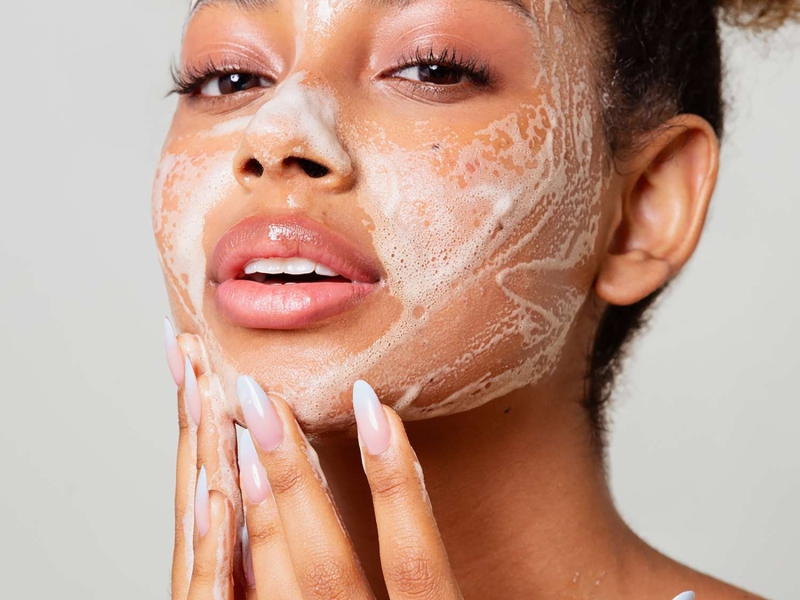Close

Additional Tips for Treating Blackheads The Final Takeaway
You’ve cultivated your perfect five-step skincare routine, developed an encyclopedic knowledge of which ingredients to use (and which to avoid), and never, ever go to bed with makeup on. You’re doing everything right. And yet there they are, clear as day, staring right back at you in the mirror: blackheads.
To be clear, there is nothing wrong or shameful about having blackheads or any other form of acne. But when you've been working hard to fight the breakouts, and it feels like you aren't winning the war, it's natural to want to find out if there are weak links in your arsenal—like, perhaps, your cleanser. We asked board-certified dermatologists Kseniya Kobets, MD, and Nazanin Saedi, MD, to break down everything from what causes blackheads to how to tell if your cleanser is effective and how to choose the best one for your skin type. Read on for what they shared.
What Causes Blackheads?
Simply put, blackheads are congested pores. “Blackheads are pores filled with excess oil, keratin, and makeup, which turn black due to oxidation when exposed to air,” says Kobets. Saedi expounds on this: “Excess oil production can clog pores, leading to various forms of acne—including blackheads,” she explains. “The black coloration isn’t due to dirt but rather a chemical reaction between clogged oil and air.”
Blackheads commonly appear as tiny black dots on and around the nose, often in the T-zone, but they can also develop on the chest, back, or ears.
How to Tell If Your Cleanser Is Too Weak
If your current skincare routine isn’t effectively clearing blackheads and acne, it may be time to reassess your ingredients and consistency. However, before assuming your cleanser is too mild and reaching for harsher products, remember that stronger products aren’t always the answer. Kobets tells us that while a “squeaky clean” feel after cleansing can be satisfying, over-cleansing can strip the skin and harm its barrier and microbiome.
“A consistent skincare routine with acne-fighting ingredients is your best path to clearer skin,” says Saedi. Choose products with replenishing ingredients—like glycerin, ceramides, niacinamide, hyaluronic acid, peptides, and botanicals—to soothe the skin and support a healthy microbiome.
What to Look For in a Cleanser
According to Kobets, there are three key elements to look for in products that help clear blackheads:
- Formulation: For oily skin, a foaming cleanser is ideal (though she recommends practicing caution, since overuse of these formulas can strip the skin, compromising the barrier and microbiome). Drier skin types may benefit from a hydrating cleanser.
- Benzoyl peroxide: She recommends benzoyl peroxide for clearing excess oil, dirt, and makeup from the oil glands. Just make sure to use white towels in your skincare routine—this ingredient can bleach fabrics—and avoid expired products since they may become irritants.
- Consider salicylic acid: This is a top ingredient for preventing and managing blackheads. “This beta hydroxy acid is oil-loving (lipophilic) and penetrates deep into pores to clear oils,” she explains. “It also has anti-inflammatory properties and may improve skin tone and pigmentation.”
Kobets cautions against using benzoyl peroxide and salicylic acid simultaneously to avoid irritation. If you’re also using a topical retinoid, be mindful of combining it with other active ingredients.
Additional Tips for Treating Blackheads
- Use retinoids: “Using a retinoid daily may be helpful,” says Kobets. Plus, “[it] and can often be paired with benzoyl peroxide or salicylic acid to reduce oiliness and pore size,” she adds.
- Be mindful of your moisturizers: Kobets also suggests scaling back on heavy moisturizers, particularly those containing dimethicone, as they can contribute to oil buildup and clogging.
- Try a spot treatment: “Acne spot treatments can also be helpful—just be sure to use them as directed,” she adds.
- Consider light therapy: Another option is blue and red light therapy masks, which can help clear active acne and reduce redness and inflammation when used consistently. “These masks are a splurge, so only invest if you’re truly committed,” advises Saedi.
- Book an in-office treatment: Depending on the severity of your acne, you can also opt for in-office options such as Hydrafacials, chemical peels, or laser treatments to reduce oil production and improve skin texture.
The Final Takeaway
It's easy to overdo (or underdo) your skincare routine in the name of clearing up blackheads. But it's important not to lose sight of the mission: "The goal is to cleanse your skin and remove excess oil while preserving the skin barrier," advises Saedi. She recommends consulting a dermatologist to develop a personalized acne treatment plan if blackheads persist despite your efforts. She also reminds us that acne is a normal skin condition, and managing it requires time and consistency. "Effective acne treatment takes patience," she says. "But with the right care, you can keep it under control."

